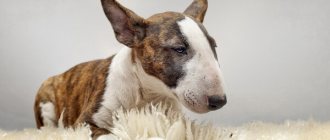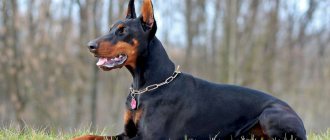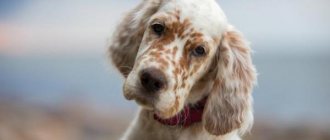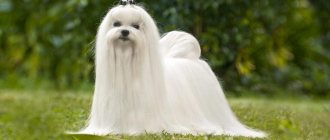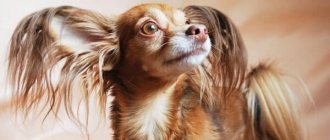The homeland of the bull terrier is Great Britain, where in the 19th century, by crossing terriers and bulldogs, the Old Bull-End Terriers were bred. The original goal for breeding Bull Terriers was very specific: to develop an aggressive and strong breed of dog for use in bullfighting.
The resulting breed corresponded to the desired characteristics: the dogs were very aggressive and hardy, with a high pain threshold.
Improving the breed interested dog lover James Hinks. In the 1850s he began experiments to improve Old Bull and Terriers and soon achieved success.
Dalmatians and Old English Terriers were used for crossbreeding, and in 1962, at an exhibition in Birmingham, they were presented with the best example of the breed at that time.
Character
This is a fighting dog that does not feel pain. Agile and resilient. With proper upbringing, where a person should dominate an animal, she will grow up to be a devoted friend.
Perfect for young owners who will play with her for a long time and go for walks.
When purchasing a Bull Terrier breed, you need to keep in mind that this dog will not obey easily. She is jealous and capricious, and if not raised correctly, she will become aggressive. It is better to grow it with affection and love.
Interesting Facts
The following interesting and unusual facts are associated with representatives of this breed:
- Stories about the “death grip” of bull terriers are nothing more than a myth, since it has been proven that representatives of this breed do not have such a feature.
- In 1980, McKenezie the bull terrier, starring in a beer commercial, became a real TV star, winning the hearts of millions of fans around the world.
- The closest relatives of bull terriers are dogs of the Gull terrier breed, which differ from their relatives in being taller and having a different head shape.
- As of 2022 In Spain, Israel, Germany, Ireland and Switzerland, these dogs are prohibited from breeding.
- Bull Terriers are brave and courageous animals. This was proven by a dog named Vila, who served in the police and saved the lives of 33 people.
What you need to know about the bull terrier
Has a tendency towards obesity. This breed is not suitable for protection. A properly raised animal will be a friendly and devoted friend. This dog does not like to live with other animals and will not tolerate competition.
The animal is quite active, so it needs daily physical activity. The dog does not tolerate loneliness well, and does not tolerate the absence of its owners at home.
The Bull Terrier is suitable for experienced dog breeders who will not give up the leadership position to a four-legged dog. Will be happy to play with your children. You just need to watch them carefully during vigorous games.
Note!
Nicknames for dogs for boys - easy, rare and most beautiful names for dogs in alphabetical order
Nicknames for girls' dogs - a list of beautiful, funny, unusual nicknames for large and small dog breeds
Maltipoo dog - everything about the dog from A to Z. Photos, description of the breed, character, maintenance features, prices, reviews
Such a breed must be adapted to the outside world as early as possible and educated, otherwise the animal will become embittered and uncontrollable.
History of the breed
The first representatives of the breed appeared in Great Britain in the mid-19th century, thanks to selection.
The historical ancestors of bull terriers are English bulldogs, Dalmatians and white terriers.
The British appreciated such traits of this breed as activity, endurance, intelligence, good manners and trainability.
The new breed quickly gained popularity. Even Oxford students and professors believed that having such a pet was a sign of prestige.
In 1887, the world's first bull terrier club was opened in Great Britain.
Initially, the dogs were exclusively snow-white, but already in the 20th century, colored varieties of this breed began to appear.
Today the breed is quite popular not only in England, but also in other European countries.
Staffordshire Bull Terrier
This breed was bred to take part in bullying. Later, when animal fighting was abolished, the Staffordshire Bull Terrier began to be used as a devoted companion.
He has proven himself to be an excellent watchdog. The dog is calm, brave, and intelligent. Loves children. A real nanny.
Types of pets
There are 4 types of the Bull Terrier breed that are allowed by the standards.
This:
- Bulldog.
- Terrier.
- Intermediate type.
- Dalmatian.
Bulldog
Distinctive features are compactness, massiveness, powerful bones, strong neck and wide chest. Such dogs are stockier and stronger, have elastic hips and a powerful body.
This type is quite rude, disproportionate and energetic, and also has a number of disadvantages:
- Short legs.
- Squatness.
- Short neck.
- Raised shoulders.
Terrier
The terrier type is distinguished by precision of lines, compactness and proportionality of the body . Typically, dogs of this type have lighter bones, a short back, straight and rather high limbs.
The disadvantages include:
- Lack of strength and energy.
- The frame is too light for this breed.
- Narrow chest.
- Excessive ease of movement.
Dalmatian
This type is distinguished by a neat and proportional exterior, a long neck and graceful limbs. The head of such pets is very long, but neat, the sides are flat, the muzzle is elongated and the tail is long.
Some representatives resemble a hound, which in no way corresponds to the standards of the bull terrier breed.
Intermediate
Intermediate type dogs took on the qualities of the other three . The head of such pets is proportional and has a slightly elongated shape. The neck is long and strong, the shoulder blades are set correctly, the paws are straight, the chest is wide. The tail is horizontal and low set.
This type of dog is less rough than the bulldog type, but stronger than terriers . At the same time, such a dog is quite compact, well built, but does not have grace.
Nutritional Features
Choose a balanced menu for your dog. This is either standard natural food or high-quality premium factory food.
The animal can quickly gain excess weight, try to keep it in shape. With proper nutrition and proper care, bull terriers live 11-14 years.
Health
Bull Terriers are naturally endowed with good health.
However, it is important to consider the following diseases to which dogs of this breed have an increased predisposition:
- Articular dysplasia.
- Deafness (congenital).
- Food allergies.
Proper, balanced nutrition, physical activity and regular preventive examinations by a veterinarian (at least 2 times a year) will reduce the risks of the above pathologies to a minimum.
The average life expectancy of a Bull Terrier under good conditions is about 12 - 15 years.
How to choose puppies
It is better to buy bull terrier puppies from a nursery, where they are vaccinated, purebred and not sick. The age should be 2-2.5 months.
Look carefully at your teeth. At this age there should be six on the bottom and six on top. White Bulls can be hearing impaired, so make sure your puppy can hear.
You can also look at the pet's parents. If something is wrong with the standards, it will be visible to the naked eye. When buying at the market, you risk bringing home a sick and outbred animal.
Care and hygiene
The Bull Terrier is unpretentious in maintenance and does not require special care. All the owner needs to do to keep the pet’s fur clean and well-groomed is to comb it with a brush (or a special mitten) once a week. When the dog sheds, it is recommended to increase the frequency of procedures to 2 times a week.
Bath the dog as needed. Moreover, as the owners themselves note, most contaminants can be removed by simply wiping the animal with a damp towel.
Bull Terriers do not need to have their nails trimmed as they grow slowly and wear down naturally during walks.
It is recommended to inspect and clean the ears with a special solution several times throughout the month. Examination and cleaning of teeth - once a month.
The pet's eyes require more attention, which must be wiped regularly to remove accumulated mucous secretions.
It is very important to ensure that the animal is sufficiently physically active. The Bull Terrier is an active dog and needs games, walks, and sports training.
Lack of physical activity negatively affects both the figure and the character of the pet.
Nutrition
To feed your pet, you can use both natural and ready-made food. However, you should not mix the two types of food.
The average serving size for an adult dog should be about 4% of the animal's weight.
It is necessary to ensure that the pet does not overeat, since representatives of this breed have such a predisposition and are susceptible to obesity.
Also, the dog should always have clean and fresh water.
Useful to know: “What vegetables and fruits can I give my dog?”
Photos of bull terriers
What do boys and girls look like and how are they different?
Bull Terrier boys are in most cases larger than girls, have stronger bones, and are also much more active and aggressive. They are born fighters and guards. Males of this breed are less tolerant of small children and other animals.
At the same time, bitches are more affectionate and flexible.
Girls look more graceful, have lighter bones and a whiter, more harmonious physique . At the same time, they are inferior to males in strength, speed and aggression. Girls are much more tolerant of children and more often find a common language with pets.
NOTE!
In bull terriers, gender inequality is quite developed, so males are often more devoted to female owners, and females prefer the company of male owners.
Price
The price of a bull terrier ranges from 10-50 thousand rubles per puppy, it all depends on its immediate ancestors. When choosing such a dog you must:
- make sure that the puppy’s parents are raising them correctly; many qualities are passed on through genes;
- Dogs with a white color are especially valued; this is considered a kind of standard for the breed;
- When purchasing a puppy, you must register it with the kennel club and conduct a thorough examination by a veterinarian;
- The breed is susceptible to some diseases, so it is necessary to get vaccinations on time.
Don't spare money on a quality collar, muzzle and leash. This will avoid conflicts with strangers, who are often afraid of such dogs. You will also need to buy toys, because the puppy is very playful and can start chewing furniture.
This is an excellent breed for keeping in apartment conditions. These four-legged friends are easy to care for and walk.
Their appearance will be enough to save your property and ensure the safety of family members. Remember that you are responsible for those you have tamed!
Types of crossbreeds
With husky
A hybrid of a bull terrier and a husky is a rather unusual and large variety of mestizos . The height at the withers of such a dog is approximately 50 cm, weight - 35 -40 kg.
The eyes are blue, and the body is sculpted, quite strong and powerful, like a bull terrier. The dog also has a large and elongated nose, short hair, softer to the touch than that of a bull terrier, but coarser than that of a husky.
The dog is calm, moderately sociable, active, but non-aggressive . If desired, you can grow a good guard out of her.
With Jack Russell
A cross between these two breeds looks very unusual, but is harmonious and proportional. The first thing that catches your eye is the pet’s nose – elongated, wedge-shaped and slightly downward.
Such dogs have a strong build, strong bones and a muzzle, like a bull terrier . They are active, very sociable and cheerful. From the bull terrier, mestizos receive strength of character, self-confidence and the ability to defend the territory.
The Jack Russell has a cheerful disposition, a love of long walks and a penchant for hunting small animals.
Such hybrids are generally less aggressive than Bull Terriers, but more stubborn and persistent than Jack Russells . Height at the withers is 35-40 cm, weight 10-12 kg, life expectancy 10-13 years.
With Labrador
A cross between these breeds is more similar to a Labrador, but much smaller in size . The physique of such a pet is powerful, strong and muscular. The head is of medium size, the nose is straight.
The color is very often red, fawn or brown, the ears are drooping and medium-sized.
As for his character, he can be called calm and friendly . Mixed breeds usually inherit activity and strength from the bull terrier, and they take the tendency to overeat from both parents, since both breeds have this deficiency.
Miniature version of the fighter
At its core, the Mini Bull Terrier is exactly the same breed of smaller dog. Such a dog has enormous willpower, incredible power, a sharp mind and a bright temperament. This rat-like dog has a multi-faceted and unique personality. Raising her is quite simple.
Guided by the standards, we can say that the miniature Bull Terrier differs from its large brother only in size. However, there are differences in the shape of the head, which resembles an apple. The dwarf pet has a slight goggle-eyed appearance. Otherwise, the dog, which resembles a rat with its muzzle, is proportional, muscular and athletic.
In the photo you can only see external differences. The video can demonstrate that the miniature Bull Terrier’s temperament is no different from its brother. The dwarf pet is perky, interesting and cheerful. It is quite easy to raise him.
Mating
Puberty occurs when the dog is 7-16 months old, but mating is recommended only at the age of one and a half years. The bitch comes into heat twice a year, mating is allowed on the 13-15th day, when obvious signs of readiness are visible: swelling of the loop, secretion of light secretions, “invitation” of the male to movements of the tail and hips.
- Before mating, it is necessary to remove worms from dogs and examine them for diseases and pathologies. In addition, it is important to choose pets that will complement each other’s good qualities and correct the negative ones. For the first time, you can invite a specialist.
- Animals are bred in the male territory. Since the weight of the female and male differs, it is difficult for the girl to stand under the male, she is supported by the stomach. The boy is sent to the noose. "Castle" may or may not happen. Sexual intercourse does not last more than 3-5 minutes; the “lock” can last up to 30 minutes. It is necessary to support the pets so that no one tries to lie down or wriggle out, this can injure the genitals.
- After mating, dogs may experience nausea, trembling, or increased appetite. This is not scary, but if the symptoms last more than 1 day, you need to contact a veterinarian.
- Mating is repeated after 2-3 days.
Feeding
For balanced feeding of a bull terrier puppy, it is better to use complete diets, for example, dry complete food for medium breed puppies Purina® PRO PLAN® Medium Puppy with OPTISTART® complex.
It is recommended to feed adult bull terriers with moderate loads diets with a sufficient amount of protein; in this case, Purina® PRO PLAN® Medium Adult dry complete food for adult dogs of medium breeds with the OPTIBALANCE® complex is suitable. If your bull terrier (weighing more than 10 kg) has high physical activity, then for feeding we recommend Purina® PRO PLAN® ALL SIZES ADULT PERFORMANCE dry complete food with the OPTIPOWER® complex for active and working adult dogs of all breeds.
Miniature Bull Terriers should be fed a complete diet for small and toy breeds. Recommendations for selecting a diet according to the needs of the dog are the same as for larger brothers, but within the framework of the Purina® PRO PLAN® Small & Mini line.
Key points in training
Training and education of Bull Terriers is the main concern of all owners. If improperly or poorly trained, a dog can become uncontrollable and dangerous. You can contact a professional dog handler.
First of all, the puppy is taught a name, a place to sleep, and the dominance of the owner in the house. All negative habits must be stopped, the dog must be punished. The Bull Terrier's intelligence helps to identify a person's weaknesses; they need a very firm hand.
Read about how to properly train a dog in the article: “Training a puppy: effective methods from dog handlers, learning commands at home.”
They were capable students, but stubborn. It takes a long time to complete the basic commands:
- "Near";
- "Place";
- "It is forbidden";
- "Quiet".
It is impossible to stimulate and encourage aggression and hatred towards animals and people. Early socialization is important in education.
brief information
| Breed name | Bull Terrier |
| Country of origin | Great Britain |
| Time of appearance of the breed | 19th century |
| Breed type | Companion dog |
| Adult dog weight | 23-32 kg |
| Height (height at withers) | 53-56 cm |
| How long do they live? | 10-12 years |
| Popular nicknames | Jacques, Pedro, Leo, Nyusha, Irma, Chloe |
A medium breed of dog, belongs to the terrier group.






